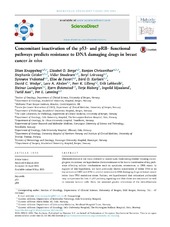| dc.description.abstract | Chemoresistance is the main obstacle to cancer cure. Contrasting studies focusing on single gene mutations, we hypothesize chemoresistance to be due to inactivation of key pathways affecting cellular mechanisms such as apoptosis, senescence, or DNA repair. In support of this hypothesis, we have previously shown inactivation of either TP53 or its key activators CHK2 and ATM to predict resistance to DNA damaging drugs in breast cancer better than TP53 mutations alone. Further, we hypothesized that redundant pathway(s) may compensate for loss of p53-pathway signaling and that these are inactivated as well in resistant tumour cells. Here, we assessed genetic alterations of the retinoblastoma gene (RB1) and its key regulators: Cyclin D and E as well as their inhibitors p16 and p27. In an exploratory cohort of 69 patients selected from two prospective studies treated with either doxorubicin monotherapy or 5-FU and mitomycin for locally advanced breast cancers, we found defects in the pRB-pathway to be associated with therapy resistance (p-values ranging from 0.001 to 0.094, depending on the cut-off value applied to p27 expression levels). Although statistically weaker, we observed confirmatory associations in a validation cohort from another prospective study (n = 107 patients treated with neoadjuvant epirubicin monotherapy; p-values ranging from 7.0 × 10−4 to 0.001 in the combined data sets). Importantly, inactivation of the p53-and the pRB-pathways in concert predicted resistance to therapy more strongly than each of the two pathways assessed individually (exploratory cohort: p-values ranging from 3.9 × 10−6 to 7.5 × 10−3 depending on cut-off values applied to ATM and p27 mRNA expression levels). Again, similar findings were confirmed in the validation cohort, with p-values ranging from 6.0 × 10−7 to 6.5 × 10−5 in the combined data sets. Our findings strongly indicate that concomitant inactivation of the p53- and pRB- pathways predict resistance towards anthracyclines and mitomycin in breast cancer in vivo. | en_US |

